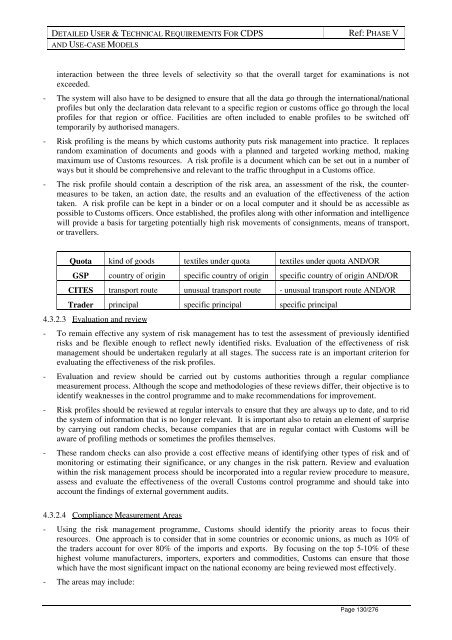Customs Declaration Processing System Detailed User and ...
Customs Declaration Processing System Detailed User and ...
Customs Declaration Processing System Detailed User and ...
You also want an ePaper? Increase the reach of your titles
YUMPU automatically turns print PDFs into web optimized ePapers that Google loves.
DETAILED USER & TECHNICAL REQUIREMENTS FOR CDPS<br />
AND USE-CASE MODELS<br />
Ref: PHASE V<br />
interaction between the three levels of selectivity so that the overall target for examinations is not<br />
exceeded.<br />
- The system will also have to be designed to ensure that all the data go through the international/national<br />
profiles but only the declaration data relevant to a specific region or customs office go through the local<br />
profiles for that region or office. Facilities are often included to enable profiles to be switched off<br />
temporarily by authorised managers.<br />
- Risk profiling is the means by which customs authority puts risk management into practice. It replaces<br />
r<strong>and</strong>om examination of documents <strong>and</strong> goods with a planned <strong>and</strong> targeted working method, making<br />
maximum use of <strong>Customs</strong> resources. A risk profile is a document which can be set out in a number of<br />
ways but it should be comprehensive <strong>and</strong> relevant to the traffic throughput in a <strong>Customs</strong> office.<br />
- The risk profile should contain a description of the risk area, an assessment of the risk, the countermeasures<br />
to be taken, an action date, the results <strong>and</strong> an evaluation of the effectiveness of the action<br />
taken. A risk profile can be kept in a binder or on a local computer <strong>and</strong> it should be as accessible as<br />
possible to <strong>Customs</strong> officers. Once established, the profiles along with other information <strong>and</strong> intelligence<br />
will provide a basis for targeting potentially high risk movements of consignments, means of transport,<br />
or travellers.<br />
Quota kind of goods textiles under quota textiles under quota AND/OR<br />
GSP country of origin specific country of origin specific country of origin AND/OR<br />
CITES transport route unusual transport route - unusual transport route AND/OR<br />
Trader principal specific principal specific principal<br />
4.3.2.3 Evaluation <strong>and</strong> review<br />
- To remain effective any system of risk management has to test the assessment of previously identified<br />
risks <strong>and</strong> be flexible enough to reflect newly identified risks. Evaluation of the effectiveness of risk<br />
management should be undertaken regularly at all stages. The success rate is an important criterion for<br />
evaluating the effectiveness of the risk profiles.<br />
- Evaluation <strong>and</strong> review should be carried out by customs authorities through a regular compliance<br />
measurement process. Although the scope <strong>and</strong> methodologies of these reviews differ, their objective is to<br />
identify weaknesses in the control programme <strong>and</strong> to make recommendations for improvement.<br />
- Risk profiles should be reviewed at regular intervals to ensure that they are always up to date, <strong>and</strong> to rid<br />
the system of information that is no longer relevant. It is important also to retain an element of surprise<br />
by carrying out r<strong>and</strong>om checks, because companies that are in regular contact with <strong>Customs</strong> will be<br />
aware of profiling methods or sometimes the profiles themselves.<br />
- These r<strong>and</strong>om checks can also provide a cost effective means of identifying other types of risk <strong>and</strong> of<br />
monitoring or estimating their significance, or any changes in the risk pattern. Review <strong>and</strong> evaluation<br />
within the risk management process should be incorporated into a regular review procedure to measure,<br />
assess <strong>and</strong> evaluate the effectiveness of the overall <strong>Customs</strong> control programme <strong>and</strong> should take into<br />
account the findings of external government audits.<br />
4.3.2.4 Compliance Measurement Areas<br />
- Using the risk management programme, <strong>Customs</strong> should identify the priority areas to focus their<br />
resources. One approach is to consider that in some countries or economic unions, as much as 10% of<br />
the traders account for over 80% of the imports <strong>and</strong> exports. By focusing on the top 5-10% of these<br />
highest volume manufacturers, importers, exporters <strong>and</strong> commodities, <strong>Customs</strong> can ensure that those<br />
which have the most significant impact on the national economy are being reviewed most effectively.<br />
- The areas may include:<br />
Page 130/276
















